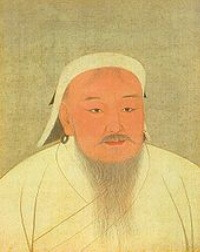
Genghis Khan, probably the most famous Mongol, was known for his terrorizing ways and for ruling a very large part of the world. As at one point almost all of Asia was dominated by his rule, Khan will be remembered historically as a very influential person.
1. World’s Largest Contiguous Empire
Khan was, of course, known for creating the world’s largest contiguous empire in history. He used his incredible charisma and personal charm to gain many followers and to keep those supporters loyal to him. He unified all of the different Mongol people and also founded the Mongol nation.
2. Universal Ruler
Genghis Khan assumed his name after the Mongolian Empire was created, about 1187. The translation of the title means Universal Ruler and was an expression of his position and desire to rule over many people.
3. Ruler of the Mongol People
Genghis Khan was proclaimed the ruler of all the Mongol people by a gathering of Mongol princes after the death of Jamuka who was a childhood friend of Khan. After Khan defeated Jamuka, many of Jamuka’s previous followers proclaimed their allegiance to Khan. Jamuka passed away in 1206 after which Khan was proclaimed the ruler of all the Mongols.
4. Subjugation or Death
Whenever Khan decided that he wanted to take over a nation or region, he was able to quickly bring them into subjugation and to rule over them. One example was his siege of the Jin Dynasty in 1211. He took control of the dynasty less than a year after beginning the siege, bringing the people came under his rule. A peace agreement was made with the emperor whom Khan later forced to flee.
5. Expansion of the Mongol Empire
Khan’s expansion of the Mongol empire toward Central Asia continued through the year 1221 and reached as far as what is now known as Iran, Afghanistan and southern Russia. The empire, the second largest in history, was larger than both the Roman Empire and that of Alexander the Great.
6. Legends
There were many legends that surrounded the life of Genghis Khan. It was said that he was born with a clot of blood in his hand which was a sign that he was destined to become a conqueror of other nations. In 1226, he was planning an attack against the Jin forces, however they had tried to revolt and died while planning for the continued attack.
7. Ruthless Warrior and Leader
Khan was known as a ruthless warrior and leader. When he defeated the Tartar nation, he ordered that everyone taller than a cart handle be executed so that loyalty could be maintained in the rising generation. The Mongol forces were able to expand their empire so quickly because they gave only two choices to those who were defeated: death or allegiance to the Mongol nation.
8. Patrillineal Descendents
Genghis Khan also contributes a great deal to the overall population of the world. Recent scientific studies have showed that his direct patrilineal descendants constitute about 8% of men in Asia. This equates to about .5% of the entire world population.
9. British Empire
The only empire that became larger than the empire founded by Khan was the British Empire in the period of international colonization.
10. Temujin
Khan was born in north central Mongolia. He was named, Temujin, after a Tartar chieftain that his father, Yesikhei took captive and took control over the area he ruled. He was a member of the Borjigin tribe and was also a descendant of Khabul Khan, who united the Mongols in the Jin Dynasty of Northern China.

Leave a Reply